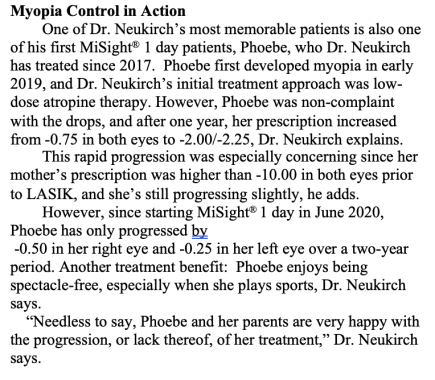
A decade ago, optometrist Andrew Neukirch, Medical Director of Carillon Vision Care in Glenview, Illinois, was exploring avenues to differentiate his practice and possibly move away from vision plans. This prompted him to attend a Vision by Design meeting, hosted by the American Academy of Orthokeratology (now the American Academy of Orthokeratology & Myopia Control or AAOMC), where he signed up for an ortho-k boot camp.
“At the time, the conversation wasn’t really focused on myopia control, but ortho-k as a way to eliminate glasses or contacts for the patient during the day,” he recalls.
Despite purchasing a corneal topographer at the meeting, Dr. Neukirch only fit two ortho-k patients that first year, one of which was a staff member.

Following an internal marketing campaign, his practice’s ortho-k patient-base began to slowly grow until before he knew it, he had successfully fit over a hundred patients just a few years later.
Looking back at his 10-years in myopia management, Dr. Neukirch cites the most significant event that influenced this segment of his practice: the 2019 FDA approval* of MiSight® 1 day contact lenses to slow the progression of myopia1 in children aged 8-12 at the initiation of treatment. 1
“That was really when I had my ‘Aha’ moment,” he explains. “The fact that we now had a medical device that was clinically proven to slow the progression of myopia[*]1 I felt that would open the floodgates of parent acceptance and make it much easier to get the conversation going about myopia and myopia management. MiSight® became my first choice for treatment, because of its proven science, ease of use, the simplicity of a daily disposable contact lens and its FDA approval*.”
Axial Length: A New Concept, a More Precise Measure
Over the past decade, new research has revealed that myopia affects the eye in a much more problematic way than what was previously believed.2 In turn, subsequent investigations have considered axial length elongation as the primary measure in myopia management.3
As Dr. Neukirch’s myopia practice continued to grow, axial length measurement became part of his standard of care in treating children with myopia.
“I started to measure axial length in all these kids and having access to these serial data points was a real paradigm shift in how I approach myopia management,” he says. “Now, my primary focus isn’t the actual prescription. Instead, I concentrate on the axial length number, and that’s what I use to educate parents. After all, slowing axial length over time is the end goal.”
Long-term Results Underscore Treatment Effectiveness
This year’s back-to-school season had a new meaning for Dr. Neukirch, since several of his now teenage patients with myopia are starting college and are being washed out of treatment. Of note, the vast majority of these patients have progressed minimally, by less than a half-diopter, over the course of five or more years.3‡

“We’ve never before had the opportunity to make such a dramatic change in the long-term ocular health 4± of these kids and in their quality of life.5 It’s also nice to have some ‘practice future-proofing’ as myopia isn’t going anywhere, anytime soon. Myopia is a problem that’s only going to get worse.6 I know our practice is going to be relevant over the next 15-20 years no matter what happens with health insurance and vision plans,” he says.
The Evolution of Parent Communication
Ten years ago, educating parents about myopia was frequently an uphill battle, since myopia was often an entirely new concept, Dr. Neukirch says. “Sometimes, people would look at me like I was crazy when most of the conversation was around ortho-k.”
In the past three years, Dr. Neukirch’s myopia conversation in the exam room has evolved and now focuses on the child’s long term ocular health and the treatment’s ability to slow progression. If parents are unfamiliar with myopia, he will explain that a myopic eye grows longer than normal, causing the retina to stretch, which can lead to problems later in life including retinal detachments and glaucoma.2,7
During the exam, Dr. Neukirch always mentions MiSight® 1 day’s FDA approval*, which resonates strongly with parents, he says.
“I always talk about that first and foremost. As a parent myself, there are very few medications or treatments that I’d ever consider putting my daughter in that didn’t have FDA approval. If my [age-appropriate] child were an equal candidate for all the available treatment options, I’d likely choose MiSight® first because of its FDA approval*, the simplicity of the lens fit,1,8† daytime wear, and its safety profile,”9 Dr. Neukirch explains.
Best Practice Advice for Newcomers in Myopia Management
After receiving MiSight® 1 day certification, Dr. Neukirch suggests ECPs starting out in myopia management should find age-appropriate patients already in their practice who would be candidates for treatment.
Another insider tip: “We always look ahead at our schedule for any kids of appropriate age for myopia management,” Dr. Neukirch says. “We pull up their charts ahead of time, in addition to their siblings’ and parents’ charts, to see if there are any high myopes in the family. More often than not, we’re able to identify candidates before they even come in, so we are already mentally prepared to have that myopia management talk with these kids and their parents even before they step in the door. That’s a big secret to our success.”
It’s also key to craft a five-minute elevator speech on myopia management, he says.
“Our consults went from me talking to parents about myopia for 20 minutes to a much more compact consult of less than three minutes that still covers the important points. You really need to practice that elevator speech,” he says.
After saturating your existing patient base, Dr. Neukirch suggests building a referral network as part of a marketing plan. “The more kids we can ultimately get into treatment, the better,” he says.
A Bright Future Ahead
As myopia cases are expected to continue to proliferate across the globe, more children will need treatment, and Dr. Neukirch projects that myopia management will become the center of his optometric practice, not a specialty.3 With this in mind, doctors should factor peer reviewed research heavily into their decision making when it comes to their myopia treatment plans, he says.
“We’re talking about kids here, and I believe this is particularly relevant when it comes to long-term outcomes for pediatric patients,4±” he says.
Considering how far the profession has come in myopia management, Dr. Neukirch says, “Who would’ve thought we’d be where we are today?”
_______________________
*Indications for use: MiSight® 1 day (omafilcon A) soft (hydrophilic) contact lenses for daily wear are indicated for the correction of myopic ametropia and for slowing the progression of myopia in children with non-diseased eyes, who at the initiation of treatment are 8-12 years of age and have a refraction of -0.75 to -4.00 diopters(spherical equivalent) with ≤ 0.75 diopters of astigmatism. The lens is to be discarded after each removal.
±77% strongly agree, 20% somewhat agree.
‡ Fitted at 8-12 years of age at initiation of treatment.
†Initial CL BVP selection and observation of fit follows same fitting protocol for single vision CLs; fit success rate same with MiSight® 1 day and Proclear® 1 day.
1. Chamberlain P et al. A 3-year Randomized Clinical Trial of MiSight® Lenses for Myopia Control. Optom Vis Sci. 2019;96(8):556-567.
2. Flitcroft DJ. The complex interactions of retinal, optical and environmental factors in myopia aetiology. Progress in Retinal and Eye Research. 2012 Nov.;31(6):622-60.
3. Chamberlain P, Arumugam B, Jones D et al. Myopia Progression in Children wearing Dual-Focus Contact Lenses: 6-year findings. Optom Vis Sci 2020;97(E-abstract): 200038.
4. CVI data on file 2022. U.S. CooperVision online survey: ECP MiSight® 1 day Perspectives; n=101 ECPs that prescribe MiSight® 1 day.
5. Rah MJ, et al. Vision specific quality of life of pediatric contact lens wearers. Optom Vis Sci2010;87(8):560-6.
6. Holden BA, Fricke TR, Wilson DA, et al. Global Prevalence of Myopia and High Myopia and Temporal Trends from 2000 through 2050. Ophthalmology. 2016;123(5):1036-1042. doi:10.1016/j.ophtha.2016.01.006.
7. Xu L, Wang Y, Wang S, Jonas JB. High myopia and glaucoma susceptibility, the Beijing Eye Study. Ophthalmology. 2007;114(2):216-20.
8. CVI data on file 2018.
9. Woods, J., Jones, D., Jones, L., Jones, S., Hunt, C., Chamberlain, P., & McNally, J. (2021). Ocular health of children wearing daily disposable contact lenses over a 6-year period. Contact Lens and Anterior Eye.








